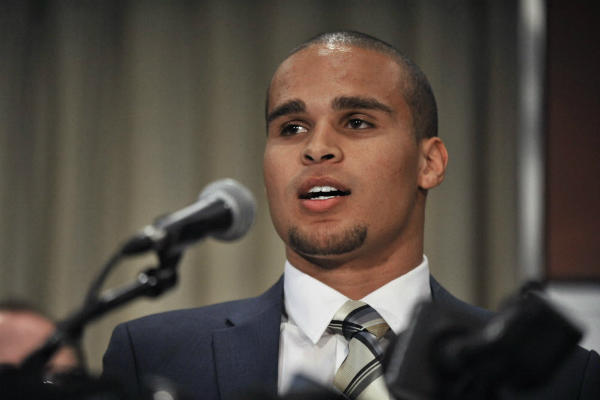
by: Alexander Hyder, 2L Contributor
Last Tuesday, January 28, a group of Northwestern football players petitioned to the National Labor Relations Board seeking approval as a labor union. The move was the latest in a series of events aimed at rectifying the current amateurism rules governing major college sports—an industry generating nearly $872 million in total revenue for the NCAA alone.[1]
Kain Colter, the now-former Northwestern Quarterback, announced the filing of the petition on behalf of his Northwestern teammates. Colter was joined by Ramogi Huma, the president of the recently formed College Athletes Players Association, and Leo W. Gerard, the president of United Steelworkers, who promised financial and legal services to the group.[2]
Colter’s message centered on the lack of involvement college-athletes play in reforming college sports. “A lot of people think this is all about money; it’s not,” Colter said. “Right now, the NCAA is like a dictatorship. No one represents us in negotiations. The only way things are going to change is if the players have a union.”[3] Colter also stressed concerns over a lack of continued medical coverage provided to college-athletes, a group in which only 50% end their collegiate careers with a college degree.[4]
If successful, the movement will allow for Division I FBS football players as well as men’s basketball players to join the CAPA. It’s thought that those athletes present the best case for being labeled as employees under the labor laws, [5] which would then make private universities responsible for providing workers’ compensation and continued medical coverage to college-athletes for injuries sustained during the course and scope of college athletics.[6]
Northwestern, given its private status, was the ideal institution for the grassroots campaign. Private universities, unlike their public counterparts who are governed by state law, are subject to the jurisdiction of the NLRB.
Northwestern athletic director Jim Phillips released a statement on behalf of the school, showing both support and skepticism. “Northwestern teaches [its students] to be leaders and independent thinkers who will make a positive impact on their communities, the nation and the world. Today’s action demonstrates that they are doing so.” Phillips agreed that the issues raised by its student-athletes are important, and “that they should have a prominent voice in those discussions,” but disagreed that collective bargaining is the proper means for addressing such concerns.[7]
On the other hand, the NCAA didn’t take too kindly to the move. Donald Remy, the chief legal officer for the NCAA, issued a statement challenging the movement’s validity. “This union-backed attempt to turn student-athletes into employees undermines the purposes of college: an education.”[8] Remy made clear the NCAA’s position that “[t]here is no employment-relationship,” and that “[s]tudent-athletes are not employees within any definition of the National Labor Relations Act or the Fair Labor Standards Act.”[9]
The announcement comes at a time where the relationship between the NCAA and college-athletes is a robust topic of conversation. Last November, U.S. District Judge Claudia Wilken partially approved certification of a class action suit against the NCAA in O’Bannon v. NCAA, which challenges the NCAA’s longstanding tradition of categorizing college-athletes as amateurs.[10] By barring current and future athletes, the partial certification paved the way for last Tuesday’s movement by empowering said athletes with the ability to bring suit on their own behalf.[11] It stands to reason that union organization of potential college-athletes may be the only viable method of achieving their goals.
What will come out of these “pay-for-play” and “seat-at-the-table” movements remains to be seen; but what is known is that the NCAA has some questions to answer both “at-the-table” and in court.
[1] http://www.usatoday.com/story/sports/college/2013/05/02/ncaa-financial-statement-surplus/2128431/
[2] http://www.nytimes.com/2014/01/29/sports/ncaafootball/northwestern-players-take-steps-to-form-a-union.html?ref=sports
[3] http://espn.go.com/chicago/story/_/id/10363430/outside-lines-northwestern-wildcats-football-players-trying-join-labor-union
[5] http://articles.chicagotribune.com/2014-01-28/sports/chi-northwestern-football-players-labor-union-20140128_1_basketball-players-labor-union-national-labor-relations-board
[6] http://espn.go.com/chicago/story/_/id/10363430/outside-lines-northwestern-wildcats-football-players-trying-join-labor-union
[9] Id.